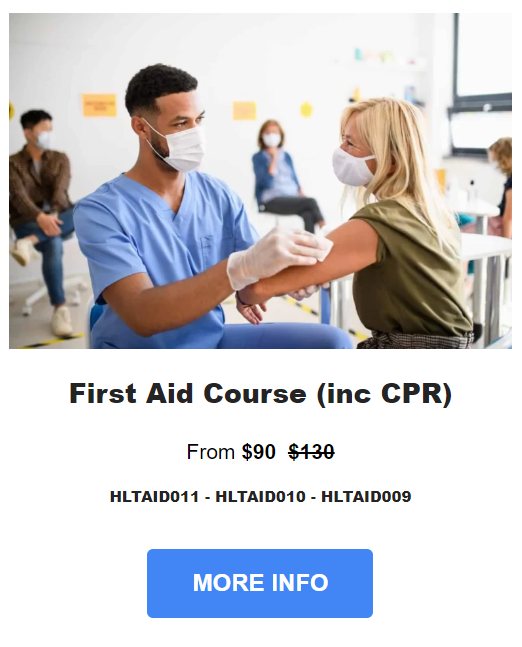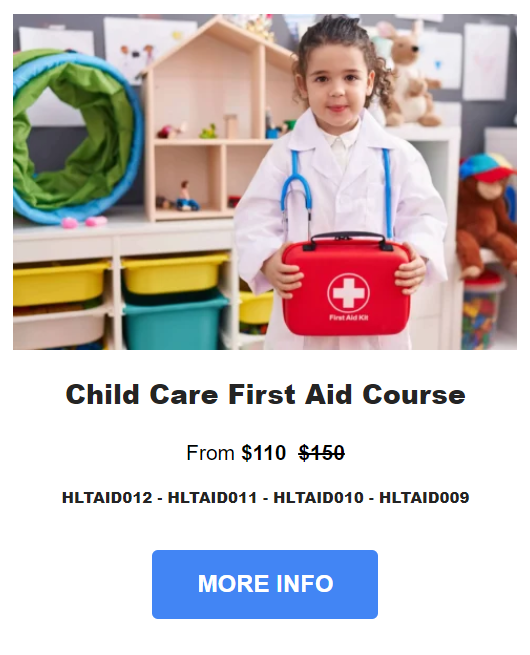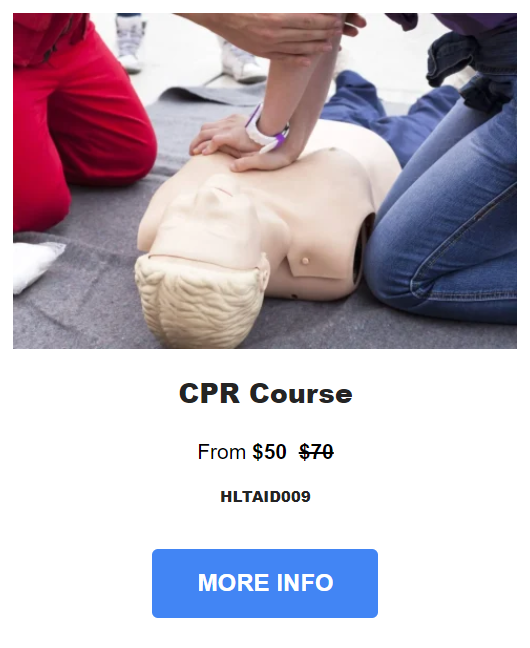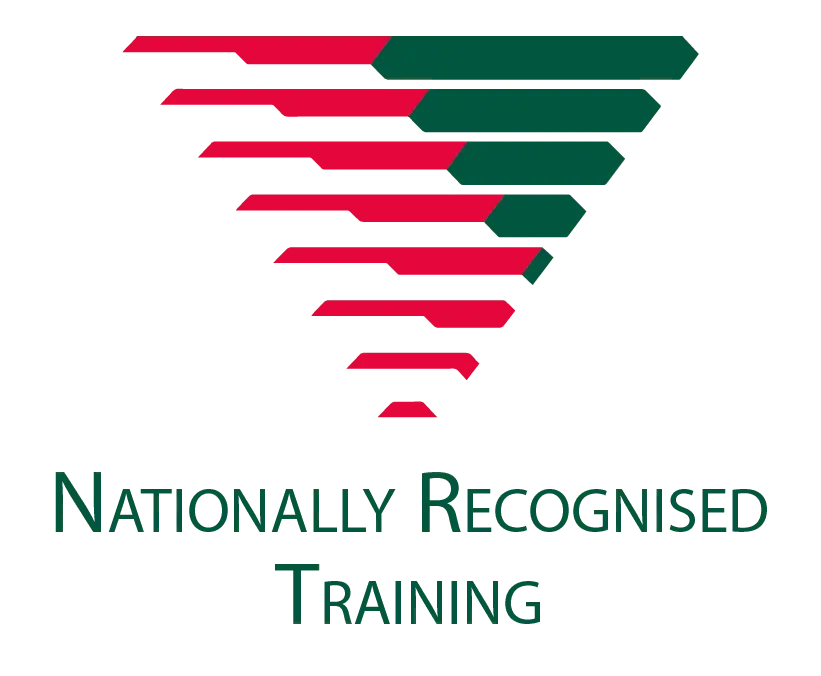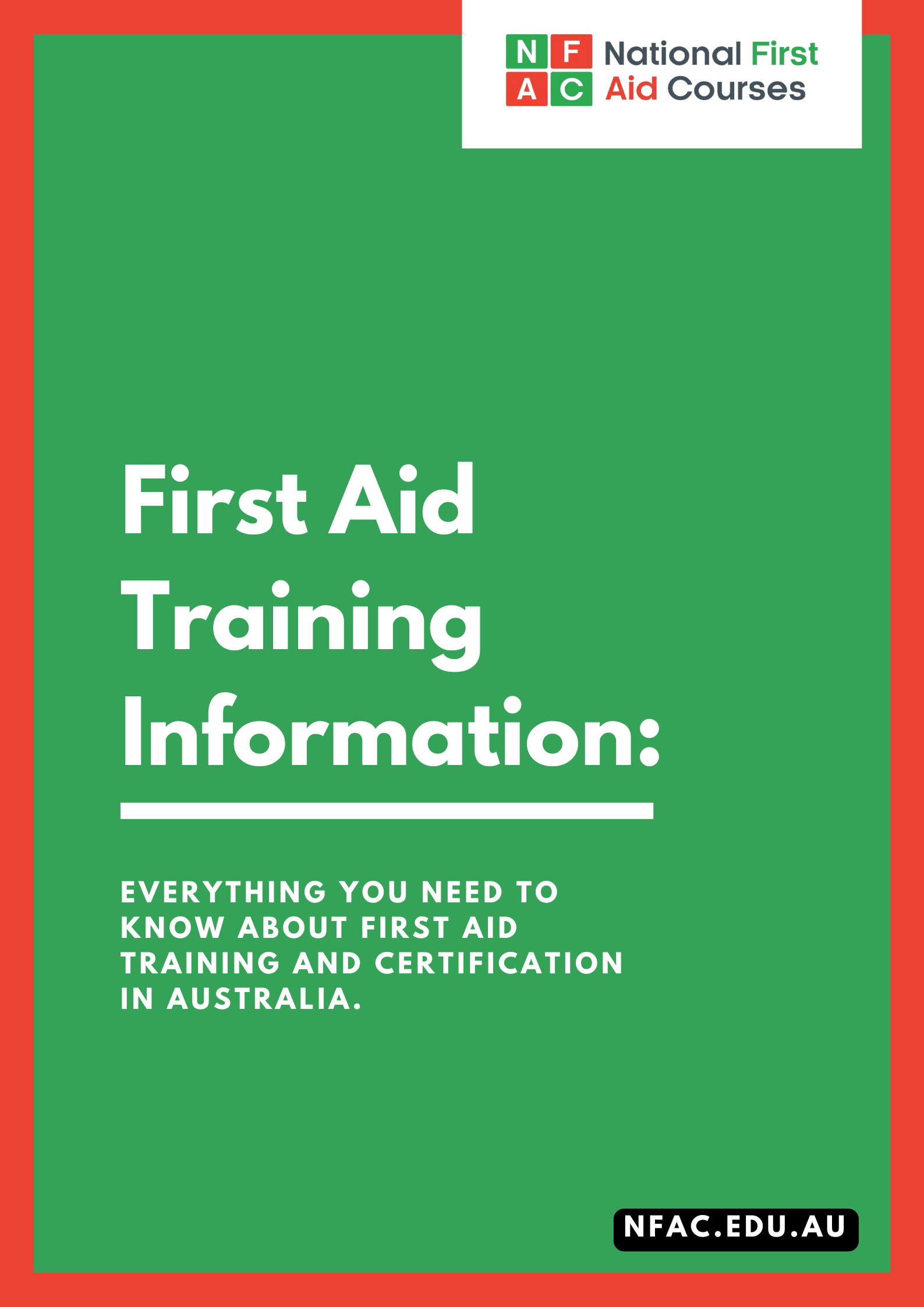
Table of Contents
Key Takeaways
- ✓ What is First Aid Training? First aid training equips individuals with essential skills to provide immediate care in emergencies, preventing further harm or complications until professional help arrives.
- ✓ Who Needs First Aid Training? First aid training is often a legal requirement for high-risk industries like construction, healthcare, and education. It's also a valuable life skill for the general public to be prepared for emergencies.
- ✓ Choosing the Right First Aid Training Provider Look for accredited Registered Training Organisations (RTOs) that offer nationally recognised first aid certification. Consider whether you need an in-person or online course based on your specific needs.
- ✓ First Aid Training Costs in Australia Expect to pay between $50 to $500 for first aid courses, depending on the type of certification and whether it's a basic CPR course or a more specialised program.
- ✓ Renewing First Aid Certification First aid certifications typically need to be renewed every 3 years (and 12 months for CPR) to ensure your skills remain up-to-date.
Introduction
Personal and workplace emergencies happen every day, and knowing how to respond can make the difference between life and death.
First aid training is critical in Australia, whether you’re a worker, parent, coach, or community volunteer.
Industries like construction, healthcare, and education may even require it for workplace safety and legal compliance.
This guide will cover everything you need to know about first aid training in Australia — from essential certification requirements to finding accredited first aid courses in Australia.
Whether you’re looking for workplace first aid or an online course, we’ll help you make the right choice.
What is First Aid Training?
Definition and Overview
First aid training equips individuals with essential skills to provide immediate care in emergencies, preventing further harm or complications until professional help arrives.
It covers a broad range of life-saving techniques and emergency protocols that are essential in both workplace and community settings.
Certification in first aid is often required for many jobs in high-risk industries like construction, healthcare, and education.
It also provides invaluable peace of mind for parents, caregivers, and community leaders.
Key Skills Taught in First Aid Courses
- CPR (Cardiopulmonary Resuscitation): Essential for reviving someone whose heart has stopped. Effective CPR can double or even triple a victim’s chances of survival if administered promptly.
- Managing cuts, burns, and fractures: Knowing how to treat these injuries reduces the risk of infection and ensures that the injury doesn’t worsen.
- Recognising signs of medical emergencies: Training teaches participants how to spot signs of heart attacks, strokes, diabetic emergencies, and more, allowing them to act quickly and appropriately.
The training is designed to be practical and hands-on, ensuring participants can confidently respond in emergency situations.
Having first aid training can significantly improve survival rates and prevent the severity of injuries, which is why it’s not just a workplace requirement but a valuable life skill for everyone.
Who Needs First Aid Training in Australia?
Workplace Requirements
In Australia, first aid training is not just recommended — it’s often a legal requirement for various industries to ensure workplace safety and compliance with Work Health and Safety (WHS) regulations.
Certain industries, especially those with higher risks of injury, are mandated by law to have employees trained in first aid.
These industries include:
- Construction: Given the high-risk nature of the environment, first aid training is essential on construction sites to handle injuries like falls, cuts, and burns. The Work Health and Safety Act 2011 requires businesses to have qualified first aid responders in place.
- Healthcare: Healthcare workers must be trained to respond to medical emergencies, including CPR, stroke recognition, and handling critical situations like cardiac arrest.
- Education: Teachers and childcare workers are required to complete first aid training, especially courses covering first aid for children and CPR, as part of their obligations to ensure student safety.
- Mining: With the high potential for serious injury, workers in mining operations are also required to have first aid training to address injuries like fractures and burns.
Compliance with WHS regulations is critical for these industries not only for legal reasons but also to mitigate the risk of severe injury or fatality in emergency situations.
Community and Personal Safety
First aid knowledge extends beyond the workplace — it’s crucial in community and personal safety as well.
In everyday life, anyone can face an emergency situation that requires immediate action.
For example, parents benefit from first aid training to manage common childhood injuries, such as cuts, bruises, or choking.
Similarly, sports coaches and volunteers in community groups like scouts often need to handle minor injuries or medical emergencies during activities.
Real-world examples of lives saved through first aid knowledge include stories of people performing CPR on heart attack victims until paramedics arrive, or treating a choking child in time to prevent asphyxiation.
According to St John Ambulance Australia, “More than 30,000 lives could be saved each year in Australia if more people were trained in first aid.”
First aid can make the difference between life and death in situations where immediate action is crucial, particularly in environments where medical help might not be readily available.
Legal and Insurance Implications
From a legal perspective, Australian workplace health and safety laws require certain businesses and industries to have a certified first aid officer on-site to meet compliance standards.
The Australian Work Health and Safety Act specifies that employers must ensure their workers are protected from health and safety risks, including those arising from injuries or medical emergencies.
Failing to have first aid-trained personnel could lead to penalties and fines.
Insurance implications are also tied to having certified first aid responders.
In case of an incident, insurance policies may require evidence that proper first aid procedures were in place.
Businesses without certified staff may face higher premiums or be at risk of not having their claims covered.
In short, first aid training is not just a life-saving skill — it’s a legal, safety, and insurance necessity that protects both individuals and businesses.
How to Choose the Right First Aid Training Provider in Australia
Accreditation and Recognised Certification
When choosing a first aid training provider in Australia, it’s crucial to ensure they are accredited and offer nationally recognised certification.
In Australia, Registered Training Organisations (RTOs) are the only institutions that can provide nationally recognised first aid training.
RTOs are registered with the Australian Skills Quality Authority (ASQA) to ensure the courses they offer meet national standards.
Look for a provider that can offer certification compliant with the Work Health and Safety (WHS) regulations, ensuring that the course is accepted by your employer or industry.
Certification that meets national standards is essential for both workplace compliance and personal credibility.
What to Look for in an RTO:
- Accreditation: Verify that the RTO is accredited by ASQA.
- Experienced Trainers: Ensure trainers have up-to-date qualifications and relevant industry experience.
- Clear Course Information: The RTO should provide detailed course outlines and explain the certification validity period.
- Testimonials and Reviews: Look for feedback from previous students to gauge the quality of the training.
Online vs. In-Person First Aid Training
While online first aid courses offer flexibility and convenience, there are important trade-offs.
Online courses might allow you to complete theoretical modules at your own pace, which is ideal for individuals with tight schedules.
However, these online courses lack the hands-on training that is crucial for mastering life-saving skills like CPR, wound management, and using an AED (automated external defibrillator).
In-person first aid training offers the opportunity to practice skills in real-world scenarios, such as CPR and bleeding control techniques, often using mannequins or other training aids.
This practical element is essential to build muscle memory and confidence in performing these life-saving tasks under pressure.
Can I Do First Aid Training Entirely Online?
CPR and First Aid courses cannot be completed fully online, as they require participants to demonstrate essential hands-on skills, including:
- performing CPR on adult, child, and infant manikins
- following the DRSABCD action plan
- correctly using a defibrillator
- bandaging and managing fractures
Due to these practical requirements, any First Aid course offered entirely online is unlikely to meet national accreditation standards in Australia.
Choosing a Course Based on Your Needs
Selecting the right course depends on your specific requirements.
Different industries and groups need tailored first aid courses to address the unique risks they face.
For example:
- Workplace-Specific Courses: Industries such as construction or healthcare require specialised first aid courses that address their unique risks. For example, a first aid for construction workers course will focus on injuries like falls, fractures, and exposure to hazardous materials.
- Community-Focused Courses: For those involved with children or community groups, courses like first aid for parents or first aid for coaches provide training on child-specific issues like choking, asthma attacks, and fractures.
- Specialised Courses: Individuals working in remote or high-risk environments may benefit from remote or wilderness first aid, which teaches skills like how to handle medical emergencies when help is far away, and mental health first aid, which covers how to recognise and respond to mental health crises.
Click the link below for more information on how to choose the right first aid course to suit your specific needs:
First Aid Training Costs in Australia
Average Costs of First Aid Courses
The cost of first aid courses varies depending on the type of course and the provider.
For instance:
- CPR Courses: These courses typically cost between $50 to $100.
- Standard First Aid Courses: These typically cost between $100 to $200 depending on whether the course is in-person or online.
- Specialised Courses: More advanced or niche courses, such as Mental Health First Aid or Remote First Aid, may range from $200 to $500.
Some industries, such as construction or healthcare, may offer funding options or discounts to cover the costs of these training programs.
Additionally, government programs sometimes provide financial assistance to community groups or volunteer organisations.
What to Expect During a First Aid Course
Course Structure and Learning Modules
A typical first aid course includes a mix of theoretical learning and practical assessments.
The theory covers emergency protocols, the signs of various medical emergencies, and step-by-step procedures for administering first aid.
Practical First Aid Training
Hands-on practice is a key component of these courses. For example, you’ll learn techniques for managing bleeding, fractures, and burns, as well as performing CPR and using AEDs.
Some providers incorporate simulation scenarios to help students experience realistic situations and respond appropriately.
Certification and Post-Course Support
Upon successful completion of a first aid course, you’ll receive a first aid certificate that is valid for 3 years (or 12 months for CPR certification).
After this period, it is essential to undergo a refresher course to maintain your certification.
Most training providers offer online or in-person refresher courses to ensure your skills are up-to-date with the latest guidelines.
How to Renew Your First Aid Certification in Australia
Renewal typically involves a half-day refresher course that covers new practices, updates to CPR protocols and a quick review of essential first aid techniques.
FAQs About First Aid Training in Australia
What Is the Difference Between CPR and First Aid?
CPR (Cardiopulmonary Resuscitation) and First Aid are both critical components of emergency care, but they focus on different aspects of patient management:
CPR is a life-saving technique used when a person’s heart stops beating or they stop breathing. It involves chest compressions and, if trained, mouth-to-mouth resuscitation or the use of an automated external defibrillator (AED).
First Aid, on the other hand, is a broader term that includes CPR but also covers a wide range of emergency interventions, including managing wounds, burns, fractures, and providing care for conditions like asthma attacks, strokes, and seizures.
Essentially, CPR is a specific skill within the broader scope of First Aid.
How Often Do I Need to Renew My First Aid Certification?
In Australia, First Aid Certification typically needs to be renewed every 3 years (and 12 months for CPR certification).
The renewal process often includes a refresher course that updates you on the latest techniques and guidelines, especially for critical skills like CPR.
Can I Get First Aid Certification Online?
Yes, you can complete a First Aid course online, but it’s important to know the limitations.
Many online courses cover the theoretical components (e.g., how to recognise symptoms of a heart attack, how to use bandages), but practical, hands-on experience is essential, especially for life-saving skills like CPR.
Some providers offer blended learning, where you complete the theoretical part online and attend an in-person session for the practical assessment.
It’s vital to ensure that the online provider is accredited and offers nationally recognised certification.
Is Mental Health First Aid Training Different from Standard First Aid?
Yes, Mental Health First Aid (MHFA) is different from standard first aid, though both are critical for community safety.
While standard first aid focuses on physical health emergencies (such as bleeding, burns, and fractures), Mental Health First Aid addresses mental health crises.
This includes recognising signs of depression, anxiety, and other mental health disorders, then providing initial support until professional help is available.
Find a First Aid Training Course Near You
Ready to gain the essential skills and knowledge to respond confidently in emergencies?
Look no further than National First Aid Courses — Australia’s leading First Aid Course provider.
As a Registered Training Organisation (RTO 41072), we guarantee you will receive the highest standard of training.
We offer official, accredited, nationally recognised first aid training at affordable prices.
Our comprehensive First Aid Courses are designed to equip you with the knowledge and certifications needed to provide life-saving assistance in emergency situations.
With face-to-face instruction, same-day certificates, and convenient locations across New South Wales and Queensland, including Sydney, Brisbane and the Gold Coast, we make it easy for you to become a certified first aider.
Enrol in one of our upcoming First Aid courses and secure your spot today!
Author Bio:

Jacqueline Lisa
Manager and Accredited First Aid Trainer at National First Aid Courses (NFAC)
With over a decade of experience in the childcare and aged care industries, Jacqueline has dedicated her career to applying her First Aid knowledge in real-world settings. As an accredited First Aid trainer and manager at National Courses PTY LTD, Jacqueline is committed to delivering nationally recognised First Aid and CPR courses across Australia. She combines her hands-on experience with a passion for teaching, empowering others with the critical skills needed to make a difference in emergency situations.
Connect on Social Media
Contact Us For Assistance
- 1300 623 613
- admin@nfac.edu.au
- Monday to Friday: 8:30 am – 4:30 pm
Share This Article:
Related Articles:
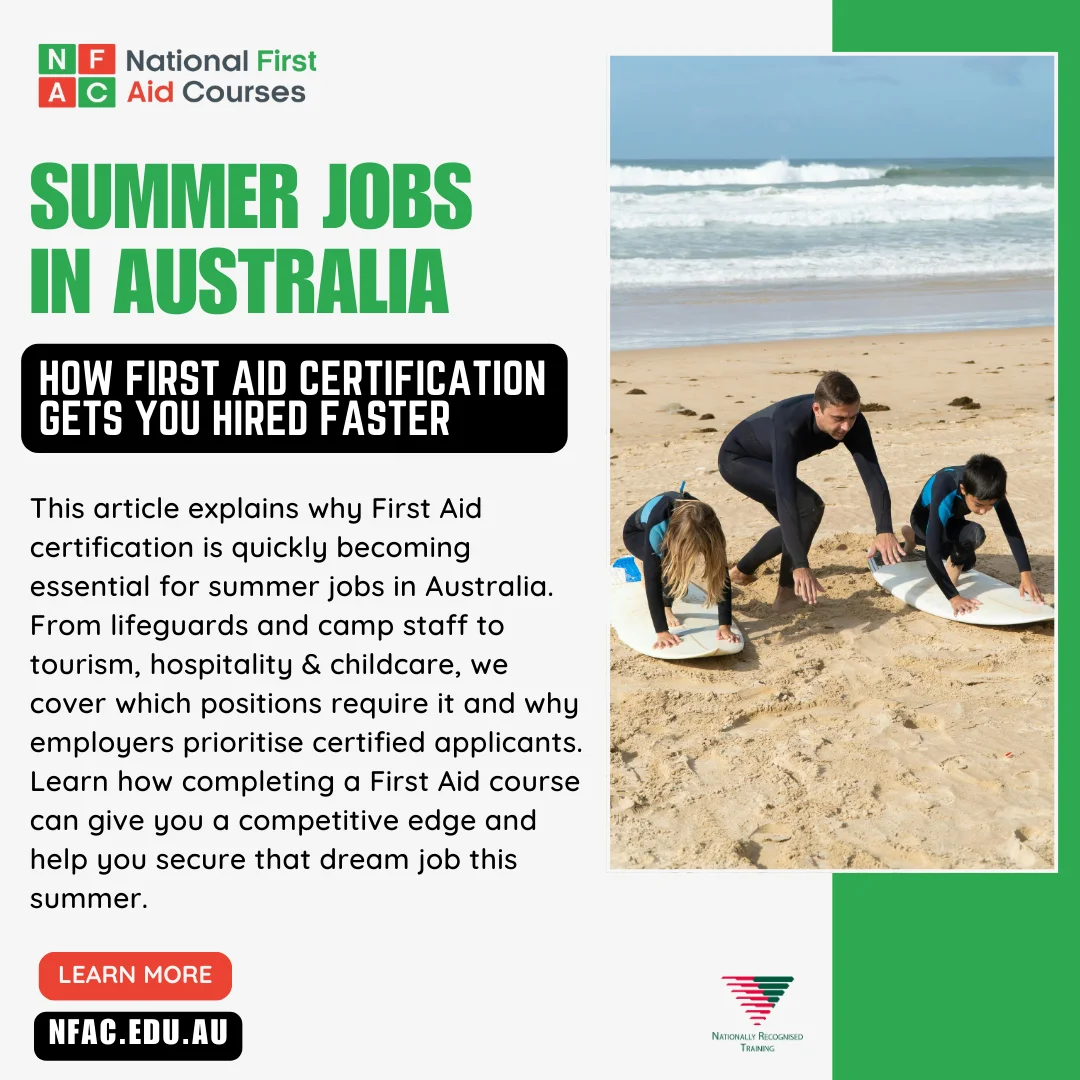
Popular Summer Jobs in Australia: How First Aid Training Can Get You Hired
In this article, we look at why First Aid and CPR training is a must-have skill for anyone volunteering at summer events across Australia. From community festivals to sports carnivals and charity fundraisers, we cover the safety expectations, heat-related risks, and the accredited training that ensures you’re ready to act fast when emergencies strike in the summer heat.

Find a First Aid Course in NSW: Sydney, Newcastle, Wollongong, Central Coast & More
In this guide, we’ll show you exactly how to find the best First Aid course in New South Wales — whether you’re in Sydney, Newcastle, Erina, or Wollongong. From understanding accredited training requirements to comparing face-to-face vs online options, you’ll learn what matters most before booking. Plus, we’ll share tips for choosing a provider that guarantees practical, hands-on skills you can trust in an emergency.
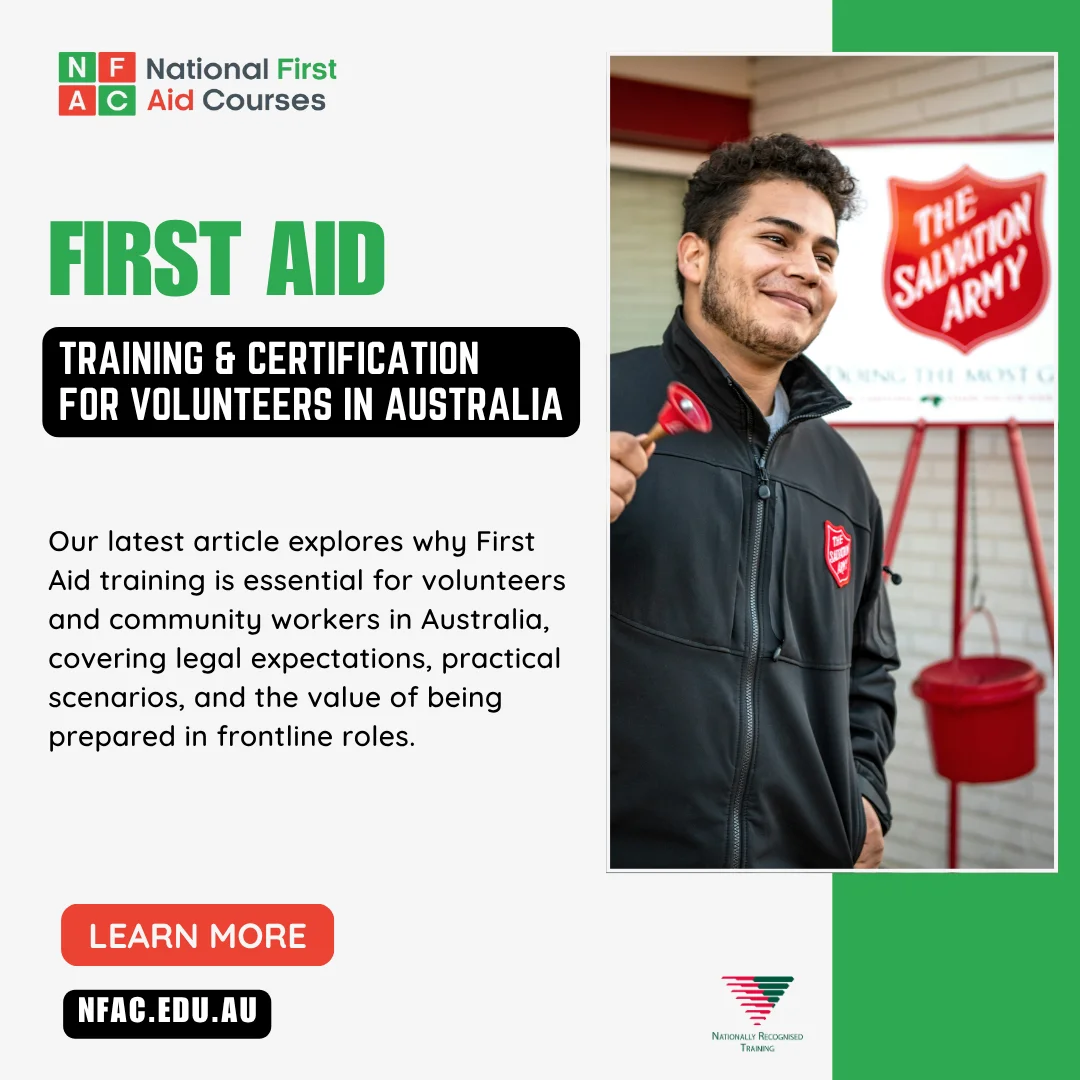
Do Volunteers and Community Workers in Australia Need First Aid Training? What the Rules Say
In this article, we explore why First Aid and CPR training is becoming essential for volunteers across Australia — not just a bonus. Whether you’re helping out at a school, charity event, or aged care centre, we break down the legal requirements, expectations from organisations, and the nationally recognised training that prepares you to step in when it counts.
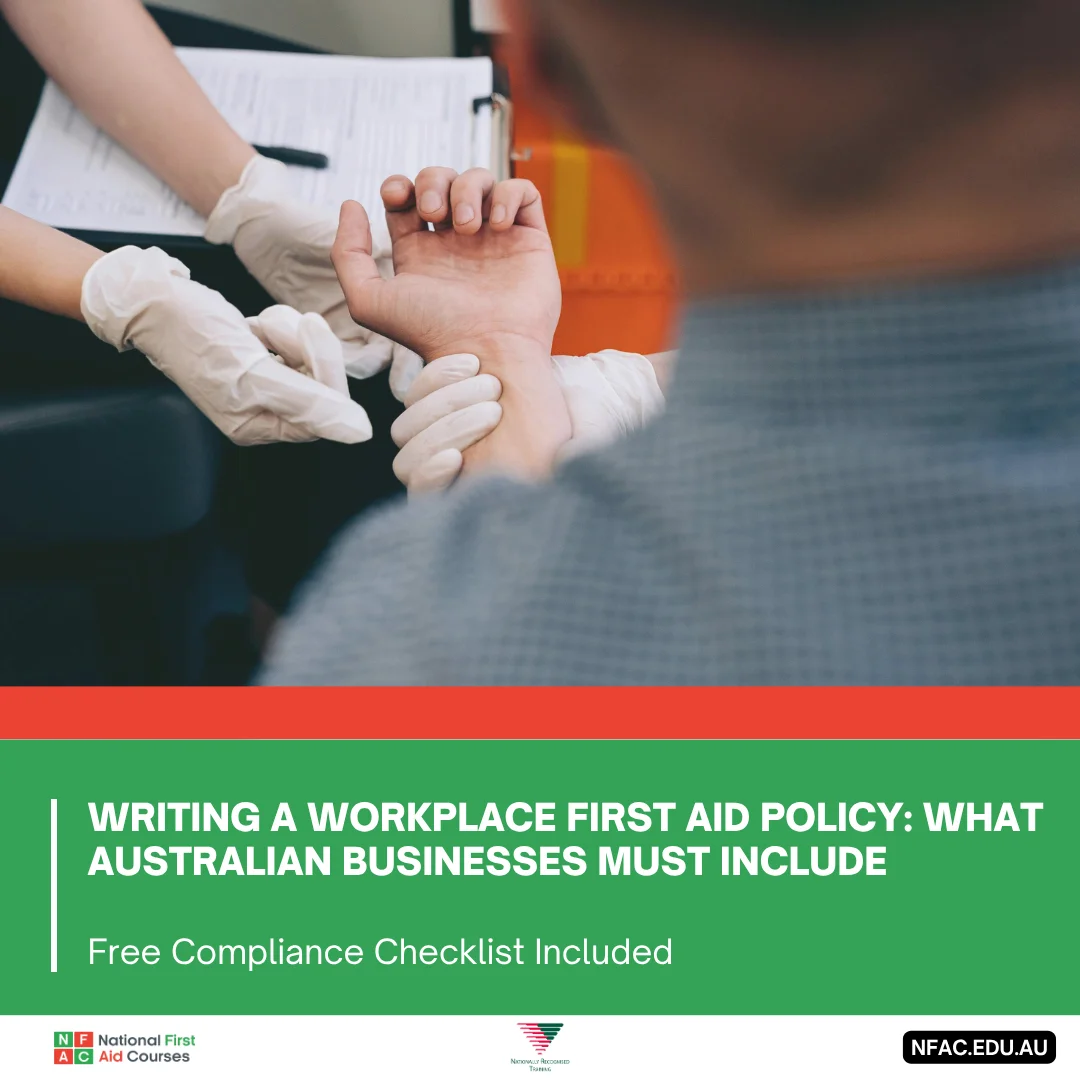
In this guide, we’ll walk you through why every Australian workplace needs a formal First Aid policy — and what should be included to meet WHS standards. From legal requirements to training and kit checklists, you’ll learn how to turn policy into real-world readiness.
